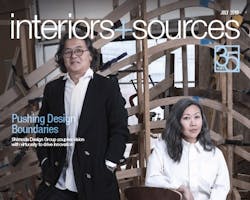Coming off the heels of NeoCon, it’s appropriate that we look at authenticity and locality in design.
Rather, we need to create spaces that encourage them to gather—and to isolate when needed—naturally.
In hindsight, lack of authenticity was the Achilles heel of the open office plan, or part of it anyway. The methodology presumed that removing all barriers was the most effective way to promote collaboration among employees.
Instead, it felt forced—fake even. And design is nothing if not genuine.
To that point, an article contributed by Be Original Americas cites the tremendous cost of counterfeits as it relates to product design and manufacturing. Not only do knock-offs infringe on intellectual property rights, but they come at the expense of innovation and American jobs.
“Supporting authentic design affords designers and manufacturers the resources and creative freedom to be innovative,” the article suggests. “It allows them to take design risks that may have the potential to fail and never come to market. It pushes the boundaries of what’s possible.”
Of course, advancing design extends well beyond product manufacturing and reaches into the realm of community transformation, which is at the heart of why so many designers do what they do.
Just ask Deon Lucas, creator of Beehyyve, a design and architecture collaborative dedicated to revitalization projects.
Lucas’ story is highlighted in this month’s IIDA column and illustrates how his passion to reconnect with his community in Chicago led to a vision for positive change through his work with the entrepreneurial collective, E.G. Woode.
“The work we do is deeply rooted in the community,” Lucas says. “It started out with me just volunteering and contributing my time and finding ways to serve the community, and as a result, [E.G. Woode] has gotten the opportunity to create a vision for neighborhood transformation.”
The idea that design can be a catalyst for change is one that Joey Shimoda and Susan Chang, co-founders of Los Angeles-based Shimoda Design Group (SDG), are intimately familiar with.
The celebrated designers approach every project with passion and care while also pushing clients to explore the possibilities that design affords them.
“I really want to communicate the notion that we really do believe that ideas want to exist to make things better; that the concepts that we’re trying to bring [to fruition], the ideas that we’re testing, the artists we work with, or the methods with which we build something, we want them to make a big difference,” Shimoda says.
For SDG, it’s not the size of the project that matters; it’s the idea that “everything has some value if we care about it,” Shimoda explains.
That’s as true for product design as it is for interiors or for the community at large.
When we care enough to invest in design ideas that are thoughtful and original, those that celebrate and encourage community and meaningful connections between people, we won’t need to wonder whether our work is imbued worth. Genuine design is good design.
About the Author
Robert Nieminen
Chief Content Director
Chief Content Director, Architectural Products, BUILDINGS, and interiors+sources
Robert Nieminen is the Chief Content Director of three leading B2B publications serving the commercial architecture and design industries: Architectural Products, BUILDINGS, and interiors+sources. With a career rooted in editorial excellence and a passion for storytelling, Robert oversees a diverse content portfolio that spans award-winning feature articles, strategic podcast programming, and digital media initiatives aimed at empowering design professionals, facility managers, and commercial building stakeholders.
He is the host of the I Hear Design podcast and curates the Smart Buildings Technology Report, bringing thought leadership to the forefront of innovation in built environments. Robert leads editorial and creative direction for multiple industry award programs—including the Elev8 Design Awards and Product Innovation Awards—and is a recognized voice in sustainability, smart technology integration, and forward-thinking design.
Known for his sharp editorial vision and data-informed strategies, Robert focuses on audience growth, engagement, and content monetization, leveraging AI tools and SEO-driven insights to future-proof B2B publishing.

